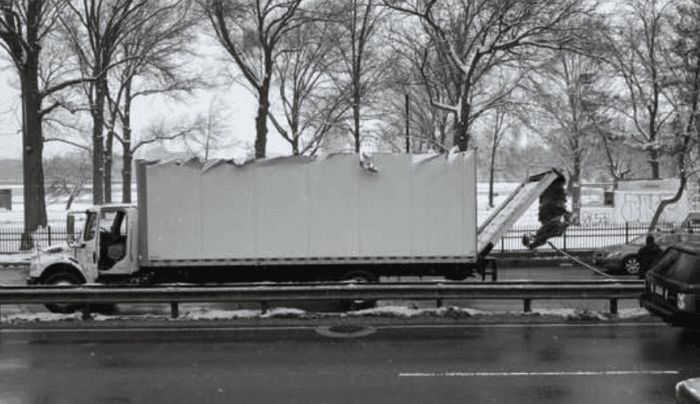
“If a truck hits a bridge, everyone is inconvenienced.”
State officials are tired of constant Storrowings—and are looking to pay at least $75,000 to create new signs that could strike oversized vehicles to prevent them from snarling traffic along the Charles River.
But a transit expert said he doubts any new signs will get through to distracted drivers and questioned what the expense would produce.
“At some point there’s nothing you can do to deal with idiots. There’s a question of what more can you do? What’s the return on investment, what is the best bang for your buck you can get,” said Ari Ofsevit of TransitMatters. “If they really want to solve the problem once and for all, close [Storrow Drive] to vehicles.”
The Mass Department of Conservation and Recreation, which oversees Storrow Drive and Soldiers Field Road in Boston and Memorial Drive in Cambridge, recently put out a request for consultants to imagine new sign designs for those roads. All have low-clearance overpasses and bridges, but the frequency of large trucks crashing their trailers or boxes into bridges on the Boston side has led to “Storrowing” becoming a shorthand term for the phenomenon. A DCR spokesperson said those crashes cause structural damage, traffic delays, and occasional injuries.
That probably would incense James Storrow, the road’s namesake. Storrow had opposed any roadways through the Esplanade when he helped design it early in the 20th century, and the road was only created after he and his wife died.
Since then, the low bridges have led to a dozen crashes a year, according to a DCR spokesperson. Ofsevit said he’s heard the frequency of crashes is greater, and that the increase of drivers unfamiliar with the area relying on navigation devices is making matters worse.
“They built this thing that has low bridges,” Ofsevit said. “The big change is that with GPS people are blindly following the glowing red triangle in front of them.”
The roads already have various special signs at on-ramps and over roadways themselves—some are rubber signs intended to make contact with over-sized vehicles, while others are electronic signs designed to light up when they detect an oversized truck, a DCR spokesperson said. But the spokesperson said the electronic signs have broken down over time and the rubber signs have not been effective.
The bid calls for a study, which the spokesperson said has a budget of $75,000, to look at replacing those existing signs. Consultants will catalog those signs and create an inventory of all crashes over the past 15 years, according to the bid, before coming up with five alternative plans for signs.
The consultant will also be involved with sign prototype testing and development, with design completion set for May 2021 and installment by November 2022, according to the bid. The scope includes researching “Intelligent Transportation System approaches,” as well as handling legal services “with regard to risk involving any DCR device intentionally making contact with an overheight vehicle.”
Still, Ofsevit was skeptical about whether new signs can stop drivers who have ignored previous ones. He suggested having oversize trucks trip lasers that would light up signs farther along the road, slowing traffic before the truck plowed into a bridge, rather than relying on signs geared toward the truck drivers themselves.
“Then you’re at least relying on other people to stop and slow down the traffic,” Ofsevit said. “Some ramps already have five or six signs, it’s not subtle. You’re relying on someone who’s already ignored not subtle signs to not ignore a bridge.”
DCR could likely make a good argument that it’s in the interest of the public to have signs striking trucks before trucks strike bridges that carry pedestrians or other traffic, Ofsevit said. Trucks carrying natural gas and buses with electrical batteries on their roofs could also cause serious damages in a Storrowing situation. But for the most part the crashes affect trucks and traffic—not the bridges themselves, he said.
“Generally, when a truck hits a bridge, the bridge wins, because the top of a truck is basically a tin can,” he said. “If a truck hits a bridge, everyone is inconvenienced—the truck gets towed, the staties slap their heads, and people post photos to Universal Hub.
“Unless bridges are being damaged, I really don’t think we need to put up something to protect bridges,” Ofsevit said. “This is something you have to deal with when you build a road through a park. If you wanted to do this right, go back to the vision of a park on the river, that’s how you solve the problem.”
Dan is a reporter who has covered Massachusetts for the Boston Herald and Gatehouse Media.

